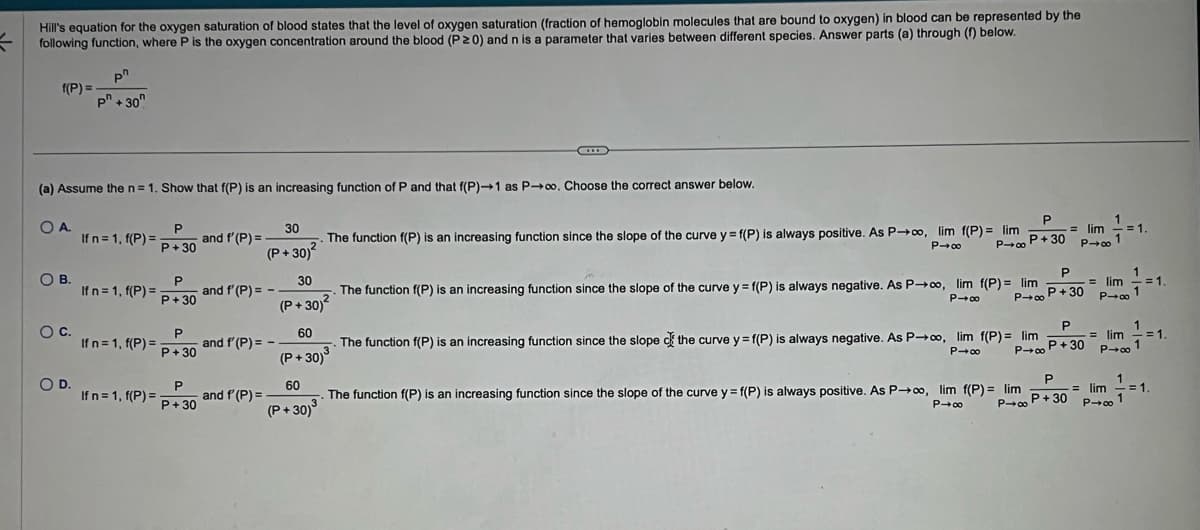Hill's equation for the oxygen saturation of blood states that the level of oxygen saturation (fraction of hemoglobin molecules that are bound to oxygen) in blood can be represented by the following function, where P is the oxygen concentration around the blood (P20) and n is a parameter that varies between different species. Answer parts (a) through (f) below. pn f(P) = p +30 (a) Assume the n = 1. Show that f(P) is an increasing function of P and that f(P)-1 as P→∞o. Choose the correct answer below. О А. О в. O C. If n = 1, f(P) = If n = 1, f(P) = If n = 1, f(P) = P P+30 P P+30 P P+30 and f'(P) = 30 (P+30)² and f'(P) = - and f'(P) = - . The function f(P) is an increasing function since the slope of the curve y=f(P) is always positive. As P→∞o, lim f(P) = lim P P→∞ P+30 P→∞ 30 (P+30)² 60 (P+30)³ 1 = lim = 1. P001 P The function f(P) is an increasing function since the slope of the curve y=f(P) is always negative. As P→∞o, lim f(P) = lim P→∞ P→∞0 P+30 The function f(P) is an increasing function since the slope of the curve y=f(P) is always negative. As P→∞o, lim f(P) = lim P→∞ = lim P→∞ P P→∞ P+30 P→∞ 1 = 1. 1 = lim = 1.
Hill's equation for the oxygen saturation of blood states that the level of oxygen saturation (fraction of hemoglobin molecules that are bound to oxygen) in blood can be represented by the following function, where P is the oxygen concentration around the blood (P20) and n is a parameter that varies between different species. Answer parts (a) through (f) below. pn f(P) = p +30 (a) Assume the n = 1. Show that f(P) is an increasing function of P and that f(P)-1 as P→∞o. Choose the correct answer below. О А. О в. O C. If n = 1, f(P) = If n = 1, f(P) = If n = 1, f(P) = P P+30 P P+30 P P+30 and f'(P) = 30 (P+30)² and f'(P) = - and f'(P) = - . The function f(P) is an increasing function since the slope of the curve y=f(P) is always positive. As P→∞o, lim f(P) = lim P P→∞ P+30 P→∞ 30 (P+30)² 60 (P+30)³ 1 = lim = 1. P001 P The function f(P) is an increasing function since the slope of the curve y=f(P) is always negative. As P→∞o, lim f(P) = lim P→∞ P→∞0 P+30 The function f(P) is an increasing function since the slope of the curve y=f(P) is always negative. As P→∞o, lim f(P) = lim P→∞ = lim P→∞ P P→∞ P+30 P→∞ 1 = 1. 1 = lim = 1.
Algebra & Trigonometry with Analytic Geometry
13th Edition
ISBN:9781133382119
Author:Swokowski
Publisher:Swokowski
Chapter4: Polynomial And Rational Functions
Section4.3: Zeros Of Polynomials
Problem 63E
Related questions
Question

Transcribed Image Text:=
Hill's equation for the oxygen saturation of blood states that the level of oxygen saturation (fraction of hemoglobin molecules that are bound to oxygen) in blood can be represented by the
following function, where P is the oxygen concentration around the blood (P≥0) and n is a parameter that varies between different species. Answer parts (a) through (f) below.
pn
f(P) =
p +30
(a) Assume the n=1. Show that f(P) is an increasing function of P and that f(P)-1 as P→∞o. Choose the correct answer below.
OA.
O B.
O C.
O D.
If n = 1, f(P) =
If n = 1, f(P) =
If n = 1, f(P) =
If n = 1, f(P) =
P
and f'(P) =
P + 30
P
P + 30
P
P + 30
30
(P+30)²
and f'(P) = -
and f'(P) = -
P
and f'(P) =
P + 30
30
(P+30)²
CI
The function f(P) is an increasing function since the slope of the curve y=f(P) is always positive. As P→∞o, lim f(P) = lim
P→∞ P→∞0
60
(P+30)³
60
(P+30)³
P
P+30 P→∞
= lim
P
P+30 P→∞ 1
P→∞ P+30
= lim
The function f(P) is an increasing function since the slope of the curve y=f(P) is always negative. As P→∞o, lim f(P) = lim
P→∞0 P→∞0
The function f(P) is an increasing function since the slope of the curve y=f(P) is always negative. As P→∞o, lim f(P) = lim
P→∞
1
P
1
= lim=1
P→∞ P+30 P→∞
P
P→∞0 P+30 P001
-= lim
The function f(P) is an increasing function since the slope of the curve y=f(P) is always positive. As P→∞o, lim f(P) = lim
P→∞
-=1.
= 1.
Expert Solution
This question has been solved!
Explore an expertly crafted, step-by-step solution for a thorough understanding of key concepts.
This is a popular solution!
Trending now
This is a popular solution!
Step by step
Solved in 2 steps

Recommended textbooks for you

Algebra & Trigonometry with Analytic Geometry
Algebra
ISBN:
9781133382119
Author:
Swokowski
Publisher:
Cengage

Functions and Change: A Modeling Approach to Coll…
Algebra
ISBN:
9781337111348
Author:
Bruce Crauder, Benny Evans, Alan Noell
Publisher:
Cengage Learning


Algebra & Trigonometry with Analytic Geometry
Algebra
ISBN:
9781133382119
Author:
Swokowski
Publisher:
Cengage

Functions and Change: A Modeling Approach to Coll…
Algebra
ISBN:
9781337111348
Author:
Bruce Crauder, Benny Evans, Alan Noell
Publisher:
Cengage Learning
